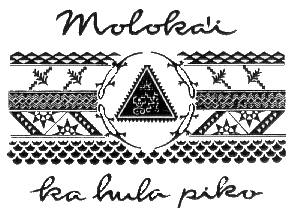|
|
 |
One and a half million years ago (give or take a week) two large volcanoes pushed through the surface of the Pacific Ocean and created the island of Molokai. Kamakou in the east, and Maunaloa in the west. A couple days later a third and much smaller caldera, Kauhako, popped up to form the Makanalua peninsula on the north side. Over eons, the north side of the island eroded and fell into the sea, leaving behind the vertical sea cliffs which today make up most of Molokai's spectacular North Shore. It's the fifth largest island in the Hawaiian archipelago; 260 square miles (420 sq km) in area, 38 miles (61km) long, and ten miles (16km) wide at its widest point. |
Anchored in the center of the 8 major islands, Molokai is 25 miles (40km) southeast of Oahu, and a 25-minute flight from Maui. From the eastern end of the island, it's only 8 miles (13km) across the Pailolo Channel to Maui.
The population is estimated at 8,000 residents, half of whom live in or near the principal town of Kaunakakai. Nearly 40% are of Hawaiian descent, thus the nick name, "The Most Hawaiian Island."
According to the experts, Hawaiians first came to live on Molokai about 650 A.D. Those first settlers most likely originated from the Marquesas, with later migrations, in double hulled canoes, from Tahiti and other areas in the South Pacific.
|
As the Hawaiians had no written language, most of their pre-contact history has come from chants, passed down from generation to generation, which have kept a chronology of events, battles and genealogy. In November, 1778, Captain James Cook sighted Molokai on his first visit to the Sandwich Islands, as he named these islands, but it wasn't until 1786 when Captain George Dixon anchored off Molokai's coast, that Europeans first visited this island. |
 |
In 1832 a Protestant mission was established at Kalua'aha on the East End by Reverend Harvey Hitchcock, to serve an estimated population of 5,000. His church has not been maintained, but the walls and part of the roof stand today at the 14.5 mile marker. A white marble headstone marks his grave on the hill east of what remains of the church.
 |
The oldest known Hawaiian settlement on Molokai occurred in Halawa Valley, at the eastern end of the main highway that crosses the length of the island. The eastern side of the island was heavily populated in pre-contact Hawaii, a result of ample water from the mountains, fertile and level land for farming, and a rich and abundant ocean. |
More than 60 fish ponds were built along the south shore of Molokai. Most have nearly disappeared, but a few have been reconstructed and are used daily by residents for aquiculture. A drive along the south shore of the island bears testimony to the reliance on the ocean by early Hawaiians.
|
Molokai was renowned for the wisdom and power of its religious leaders, greatly respected and often feared by others in the archipelago. In the 1500s, the famous prophet, Lanikaula, was so revered that pilgrims came from all the Islands to seek his wisdom and advice. Molokai became a place of retreat, protected from war by its religious prestige and the marital alliances of its chiefs. |
 |
Others were reputed for sorcery. Legend tells of the Kalaipahoa, or poisonwood gods, entering trees on Maunaloa. The grove is said to have been so poisonous that birds fell dead as they flew over it.
Legend also tells us that Laka, goddess of the hula, gave birth to the dance on Molokai, at a very sacred place in Ka'ana. This is recognized on Molokai every May, at a celebration of the birth of hula, called Ka Hula Piko.
When Laka died, her remains were secretly hidden somewhere beneath the hill, Pu'u Nana. The hula was finally established, the work of Laka was complete, and the dance flourished throughout Hawaii.
|
Molokai was praised as "Molokai Ka Hula Piko," Molokai, the center of the dance. This design, by John Kaimikaua and Wainwright Piena, uses traditional Hawaiian motifs to depict the essence of the saying, "Molokai Ka Hula Piko." To the early Hawaiians the mo'o (lizards) were a symbol of spirituality and good fortune. |
 |
The central design depicts this spiritual continuity with the mo'o arranged in a circle. The triangle depicts a Hawaiian value called "Lokahi," which is symbolic of a balance between man, nature, and God. Petroglyphs within the triangle portray a man and woman in dance. In the uppermost part of the triangle is a rising sun with a dot in the center symbolizing the piko of the hula.
Beneath the circle is a motif depicting water, while at the top, the triangles represent fire. In the real world, water and fire are the two elements that cannot be mixed, but the spiritual essence of these elements mix in the hula. The ancient kumu hula of Molokai stressed to their students that they should dance with the fluidity of water and with the spark of fire.
The middle row of diamonds, is a design called by the Hawaiians "na maka ke akua," or "eyes of the gods." Eyes are symbolic of the past, because our ancestors look upon us and guide us in this life. Eyes also represent the living, as we look back upon the paths of our ancestors for inspiration and guidance.
The hula provides a means for us to look back to the works of our ancestors through its movements, motions and chants.
Above the "na maka ke akua" design are ferns representing the greenery worn by the dancers and below is the half-circle-point motif representing the rays of the sun rising in the east.
To the early Hawaiians, the rising sun was symbolic of constant renewal and rebirth in the hula.